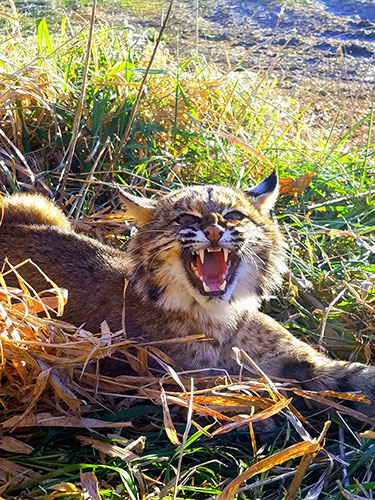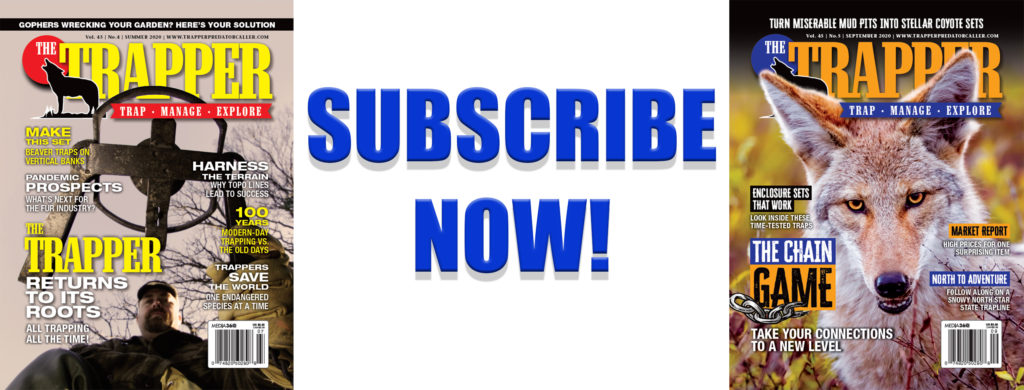Blind trail sets can be dynamite on the bobs’ travel routes. Here’s how the author uses them to his advantage.
Text and photos by Jason Houser
Trappers across the country eagerly await the first check of the season. There are no words to explain the excitement of a catch, and for me that excitement increases tenfold with the catch of a bobcat. Catching a bobcat is a common occurrence in some parts of the country. For others, it is pure luck to have a bobcat in the area to even investigate the set. Still for others, to catch a bobcat you might have to travel to another part of the state or entirely different state altogether.
Catching a bobcat is not always a guarantee, though, no matter where you live. These elusive critters can walk for days before ever returning to the same spot. This is especially true with large males. A female will live in an area of about six square miles. The territory of a male bobcat averages 60 square miles. That is a lot of ground to cover.
While thinking about how far a bobcat travels, it is your job to then figure out where it may step, put a trap there and then convince that animal to step on a 1½-inch circle, or walk through an opening just a few inches in diameter when it has 60 other square miles to walk in.

Bobcats, especially the males, can travel extremely long distances before returning to the same area. Photo credit Jason Houser
Fortunately, trappers have at their disposal an array of sets for targeting bobcats. Many trappers rely on curiosity flagging of some sort, a cubby set or other tricks they have up their sleeves to convince a cat to stick its head or foot where it does not belong. What many trappers fail to realize, is just how effective a blind set can be, particularly a blind trail set.
Now, I have used blind trail sets in the past for furbearers with good success. But, it wasn’t until a couple years ago when I was tagging along with Adam Kane on his Minnesota bobcat line that I learned just how effective a blind trail set can be.
Not only are they easy to set, but you don’t have to worry about using messy animal carcasses as bait, flagging to get the cat’s attention, or any of that other extra stuff associated with being a “good” bobcat trapper.
Don’t get me wrong, there is still a place on the line for cubbies and flagging and all of that other good stuff. I have just come to realize that a bobcat stepped in a certain spot for a reason, and it is likely to step there again. So, why not set a trap there?
Bobcats have certain areas they use as hunting ground. When they are active in their hunting areas, they are not likely to stay on a certain path as they search for food. But, it’s the path they take to their hunting grounds that gets them into trouble.

In areas of the country with a lot of snowfall, it can be tough to keep footholds working through the winter. Photo credit Jason Houser
Bobcats often use a well-defined path as they move from hunting area to hunting area, and with a little legwork, you should be able to find where they regularly cross roads, meadows, streams, and travel down roads, etc.
Of course, it is easier to find these paths in areas of the country where there is snow on the ground. If you do not have snow cover, tracks left in mud or dirt might be a telltale sign of where the cats are moving. Even a small-game trail could be used by bobcats. It’s going to take some work to find them, but the amount of cats you can catch is worth it.
Bobcats do not like to be in the wide open for very long. If you have paid attention to where you have seen them cross roads, they often do it where both sides of the road have woods very nearby. Keep in mind that bobcats are not like deer, when they cross the road they do so in a hurry. They are not going to be standing still for you to get a good look at them.
If you happen to see a bobcat cross a road, come back to that area and check it out for a crossing. There is a good chance you will find one. Bobcats have been known to even cross under the roads through culverts. In the right location, old over-grown beaver dams are also often used by bobcats. Even just a narrow strip of cover through open spaces is a good place to look for trails.
When making blind trail sets for any animal, you are not only trying to predict where that animal will walk, but also eventually put its foot. That is a big task, but it can be accomplished.
As trappers, you basically have three choices, depending on the laws where you trap. Body-grip traps, foothold traps and snares are the three best tools you have in your arsenal.
Depending on where you live in the United States, a foothold might be the only trap you can use to target bobcats. The main reason a foothold would be your only option is if there are size restrictions on body-grip traps, if body grips are illegal or if snares are not allowed.
It is nice to have a lethal set for bobcats, but all is not lost if it’s no allowed.
The jury is still out on how the traps need to be concealed. Many trappers get away with just breaking up the trap’s outline, not actually burying them. I have concluded that a cat hunts with its eyes, so I want the trap buried and hidden.
I like to work peat moss around the jaws of the trap and then cover it with whatever is natural to the area. That might be pine needles, dirt, grass, etc. Once freezing weather sets in I begin to use waxed dirt or cover hulls to keep the trap firing. I finish the set off with a thin layer of other nearby natural material.
If you set your trap with a stake and you make a catch, don’t expect to catch another bobcat there if the area is torn up badly. For this reason, I like to use drags. Either a commercial drag or a drag made on site will work fine. Do not use a dead branch as a drag that could easily be snapped in half. Instead, use a live branch or sapling at least 6 feet in length and 1½ inches in diameter.
Another thing that I like to do is use stepping sticks to guide the bobcat’s foot onto the trap’s pan. Also, I put a sharp stick about 2 inches in length between the trap’s jaws. Animals are just like humans and prefer not to step on something uncomfortable.
I have caught and held cats in just about every trap imaginable. I have walked up on bobcats in a Duke 1½, and all of the way up to a No. 4. When I have caught bobcats in #1½ traps, they were on trail sets intended for ‘coons. They did hold those cats, but I wouldn’t recommend doing it on purpose. My preferred trap is a Duke No. 3, but I am making the switch this year to use the 550 from Duke. It is a strong trap that will hold any animal that steps on the pan.
Just remember, when setting for bobcats, use at least 3 pounds of pan tension. You want that cat to be fully committed to stepping on the pan when it fires. The result will be a good, high catch.
Another popular trap style for trail sets is the body-grip style of trap. They are often the only option besides snares in areas with a deep snow covering, and footholds would not work. Depending on the state you are trapping in, there might be laws on using body grips on the ground. Many states have size restrictions, and other states will require these traps to be dog-proof. This means they have to be recessed into a cubby of some sort or off of the ground.
If you are fortunate to live in a state that allows you to use a 220 body grip on the ground, this is a perfect trap for bobcats. Choose any size smaller of a trap and I would not be confident in it effectively putting the cat down like the trap is intended to. Any larger size and chances are it is illegal, plus you really don’t need a trap bigger than a 220.
In the past I used the square-style body grips for many years until I was introduced to round body-grip traps (RBG Traps). Since they are round, I feel like it is easier for bobcats to attempt to enter them. Just remember to block these off well on the sides and over the top. A round entrance just appears more natural than a square. Bobcats are often comfortable entering a tight space, whereas other animals, such as a fox, might resist going through something that does not have much room.
Even though a body-grip trap is intended to kill whatever passes through it, it might not happen instantly. For this reason, be sure to have the trap tied off to prevent a hefty bobcat from walking off with your trap.
Snares are another method for making blind trail sets for bobcats. Snares are lightweight and durable and are perfect if you have to travel a good distance on foot to make sets. Just like when you are making a set with a body-grip trap, narrow down the opening that the bobcat has to walk through.
I make my loops 8 to 10 inches in diameter and place them 5 to 6 inches off of the ground. Many trappers make their loops in the form of a teardrop, with the thought that it will speed the snare up. I have never tried it, but many trappers swear by it.

Snares are perfect for setting far from any road when you have a heavy load to carry. Photo credit Jason Houser
When using a snare, know the laws where you are setting. Many states require snares be equipped with a deer stop to prevent the snare from closing completely. If the state you are trapping in does not require a deer stop, you should still consider using one.
Catching a bobcat using any method is an accomplishment that you should be proud of. To get out and scout the area and learn the habits of the bobcats you are targeting, and placing a trap or snare in the middle of nowhere, and having a bobcat get caught is truly outsmarting one of the smartest critters on the trapline.
In the beginning, it might be frustrating when things don’t work out like they are planned. But with time, you will get better at reading what the bobcats are doing, how to interpret where they will be traveling, proper trap placement and everything else it takes to catch one without the aid of attractants.
#28: BE A SUCCESSFUL TRAPPER with Alan Probst | Deer Talk Now Podcast





